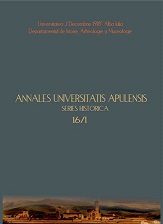Aşezări, domenii şi biserici în Transilvania medievală (II). Nord-estul comitatului Alba
Settlements, Domains and Churches of Medieval Transylvania (II). The north-east part of medieval Alba County
Author(s): Ileana BurnichioiuSubject(s): History
Published by: Editura Mega Print SRL
Keywords: Ecclesiastical topography; church; medieval architecture; medieval villages; Alba County
Summary/Abstract: This paper is the second part in a series of case studies analyzing medieval churches (parochial churches, chapels, oratories) from Transylvania, especially from the medieval counties of Alba and Hunedoara, in conjunction with data concerning the settlements and the domains within which they functioned . The case studies are relying new researches on archival documents (written and visual sources), archaeological results and monuments, amending the views expressed in the scholarly literature. The last part of the series aims to formulate new questions and conclusions about rural medieval churches. The second part of the series focuses on a territory of cca. 715 km2, bordered by Mureş Valley (in the north) and Târnava Valley (in the south), which belonged to the medieval county Alba (Fig. 1-2). The medieval churches of this area were little studied in spite of the fact that information existed in various archives and the buildings themselves preserve clear signs of Romanesque, Gothic, and Renaissance construction stages, in the Reformated churches from Bucerdea Grânoasă, Herepea, Şilea, Iernut, Noşlac, Rădeşti, Sâncrai, and in the Unitarian church of Sânbenedic or in the ruins of the Roman-Catholic church of Ocna Mureş. The area under discussion was inhabited by people belonging of Orthodox and Roman Catholic allegiance. The sources of the thirteenth-sixteenth century describe a highly heterogeneous society, with ethnic groups such as Romanians, Hungarians, Szeklers, Germans (near Aiud). The medieval landed properties belonged to ecclesiastic and lay owners, with a preponderance of noble landowners in the case of lay properties. In the south, there was an extension of Geoagiu domain beyond Mureş river, in the north several villages belonging to the family of Mikud ban, and within the area, several enclaves pertaining to ecclesiastical institutions, such as the Bishopric of Transylvania, the Bakonybél abbacy (Veszprém county), the chapters of Alba Iulia, Arad, and Buda), next to the villages of lesser nobility, numerous and with lots of branches, from the families Mike/Miske, Bogati, Gombási, Csombordi, Csekelaki, Sulyei, Forroi, Szentkiralyi etc. We are attempting to pinpoint on the map and analyze all information regarding the medieval churches within this complicated network of settlements and estates with various lords.
Journal: Annales Universitatis Apulensis Series Historica
- Issue Year: 16/2012
- Issue No: 1
- Page Range: 47-140
- Page Count: 94
- Language: Romanian
- Content File-PDF

